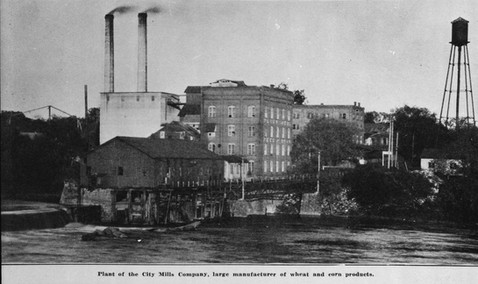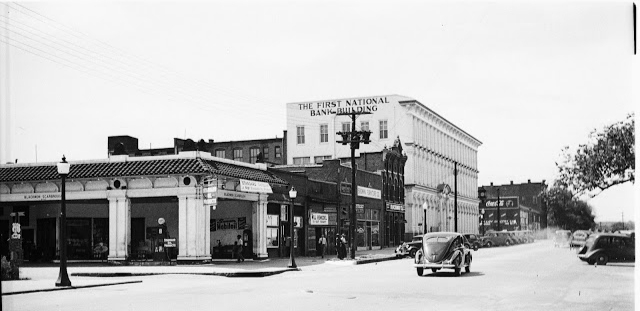The Central Business District - Before Uptown
- Historic Columbus
- May 22, 2024
- 4 min read
SOURCE: Historic Preservation in Columbus, Georgia. An Official Publication of the Columbus Area Bicentennial Committee. April 1976. The booklet was prepared for the Committee through the cooperative efforts of the Lower Chattahoochee Area Planning and Development Commission, the Columbus Museum of Arts and Crafts, and the Historic Columbus Foundation.

Wood, brick, cast iron, and cast concrete suggest the chronological story of commercial construction in the Central Business District. From records, it is known that most of the early structures in downtown Columbus were of wood construction.
The Great Fire of Columbus occurred, in 1846, in an area south of Eleventh Street, from First Avenue – west to the river, and to one block south of the Dillingham Street Bridge. If the title, Oldest Commercial Building in Columbus, were to exist, the structures it described would probably be found in this burned-out area. Recently discovered was a commercial building, believed to have been built between 1852 and 1859 which may be the second oldest commercial building in the city. This recent discovery was the old headquarters of the Muscogee Fire Company No. 3 (below - third facade from right), a volunteer fire company that operated in the 1850s. It is located in the Rankin Square block on First Avenue.
Although much of the visible construction in downtown Columbus dates from the decades immediately following Reconstruction, such as the mills along the Chattahoochee and the warehouses on Front Avenue, there are a number of antebellum structures in downtown Columbus still in use.

Some of the Columbus Iron Works, soon to be incorporated into the city's Trade and Convention Center, date from 1857, and the complex is listed on the National Register. The office of the Fieldcrest Mills (The Mott House), built in 1848, is a former residential structure. It was the home of Daniel Griffin and later the home of Randolph Mott. The building is also listed on the National Register.
It is well-accepted that the oldest business in Columbus is City Mills, dating from the city's founding in 1828. The mill lays claim to being the oldest, continuously operating, commercial grist mill in the United States. Its waterfront mill was built about 1845.
The Victorian Rankin Hotel, soon to undergo restoration and adaptation for new uses, is an articulate example of 19th-century commercial architecture. The hotel's entrance, facing Broadway, is characterized by a beautiful two-story cast-iron porch, which has been highly praised by visiting architects, architectural historians, and city planners.

The two most important historic commercial structures in the downtown area are the First National Bank building (Iron Bank), on the corner of Eleventh and Broadway, and the Springer Opera House at First Avenue and Tenth Street. Both of these buildings are listed on the National Register. The bank is a wonderful tri-storied building designed in the Italian Renaissance style with a cast-iron facade on two sides.
According to Alan Gowans, Images of American Living, "Large-scale architectural use of iron was first introduced, apparently, by John Haviland in a facade designed for the Miner's Bank of Pottsville, Pennsylvania, in 1830. By the 1850s, cast-iron facades were becoming common."
The First National Bank bears a remarkable resemblance to an illustration in Gowans' book, advertised by the Badger Architectural Works, circa 1855. According to local information, the architect for the bank was Samuel B. Hatcher who probably had it cast in Pittsburg. The structure was built for the offices of the Georgia Home Insurance Company. Construction began before the outbreak of the Civil War but was not completed until after the hostility ended. Another building with a cast-iron front facade exists at 1111 Broadway.

The denaturing of many commercial structures has occurred in the form of plastic materials being added to the brick and masonry facades, often accompanied by a proliferation of overhanging signs of a garish nature. This modernizing was begun about 1940 and proceeded with unfortunate vigor well into the present decade. That these attempts to modernize business districts were a trend throughout the entire nation, is not a particularly consoling fact. Several of the study plans to revitalize the downtown area have urged the wholesale removal of these false fronts, and a return to the earlier and more original storefronts. The elimination of overhanging signs has also been strongly urged.

Handsome churches have occupied several blocks in downtown Columbus since the antebellum days. The First Baptist Church, an impressive structure in the Greek Revival style, was built in 1859. The First Presbyterian's Romanesque-style sanctuary was built in 1862. The building suffered a fire in 189 but was rebuilt within its charred walls. These antebellum structures have been enlarged in the 20th Century but with great care and taste.
Although not antebellum, the churches belonging to the Roman Catholics, the Methodists, and the Episcopalians are exceptionally beautiful buildings, and are prized by their congregations. These five downtown sanctuaries have been invaluable in sustaining the character and appearance of downtown Columbus.

The Central Business District of Columbus has the potential to become again the focal point of the city. While the area may never again serve as the primary retail, the full development of its potential as the city's governmental-institutional-entertainment center will produce a unique and valuable retail sector.
Plans for downtown are no longer just being talked about, active movement is underway to revitalize the district. Positive attitudes and active support on the part of Columbus citizens can speed the process of again making downtown Columbus the heart of their city, a place of which to be proud. (Editor's Note: Remember, this was written in 1976 - the vision was there, and it is now our reality!)































https://maps.google.com.ua/url?q=https://millecoffee.com/menu
https://www.google.co.nz/url?q=https://millecoffee.com/menu
https://images.google.co.nz/url?q=https://millecoffee.com/menu
https://www.google.ro/url?q=https://millecoffee.com/menu
https://images.google.ro/url?q=https://millecoffee.com/menu
https://www.google.ro/url?sa=t&url=https://millecoffee.com/menu
https://maps.google.no/url?q=https://millecoffee.com/menu
https://www.google.no/url?q=https://millecoffee.com/menu
https://maps.google.co.za/url?q=https://millecoffee.com/menu
https://images.google.co.za/url?q=https://millecoffee.com/menu
https://images.google.com.ph/url?q=https://millecoffee.com/menu
https://maps.google.com.ph/url?q=https://millecoffee.com/menu
https://www.google.com.ph/url?q=https://millecoffee.com/menu
https://www.google.gr/url?q=https://millecoffee.com/menu
https://www.google.gr/url?sa=t&url=https://millecoffee.com/menu
https://maps.google.com.ua/url?q=https://og.vegamovies.mex.com
https://www.google.co.nz/url?q=https://og.vegamovies.mex.com
https://images.google.co.nz/url?q=https://og.vegamovies.mex.com
https://www.google.ro/url?q=https://og.vegamovies.mex.com
https://images.google.ro/url?q=https://og.vegamovies.mex.com
https://www.google.ro/url?sa=t&url=https://og.vegamovies.mex.com
https://maps.google.no/url?q=https://og.vegamovies.mex.com
https://www.google.no/url?q=https://og.vegamovies.mex.com
https://maps.google.co.za/url?q=https://og.vegamovies.mex.com
https://images.google.co.za/url?q=https://og.vegamovies.mex.com
https://images.google.com.ph/url?q=https://og.vegamovies.mex.com
https://maps.google.com.ph/url?q=https://og.vegamovies.mex.com
https://www.google.com.ph/url?q=https://og.vegamovies.mex.com
https://www.google.gr/url?q=https://og.vegamovies.mex.com
https://www.google.gr/url?sa=t&url=https://og.vegamovies.mex.com
https://maps.google.com.ua/url?q=https://korean.atopvacuumcoating.com
https://www.google.co.nz/url?q=https://korean.atopvacuumcoating.com
https://images.google.co.nz/url?q=https://korean.atopvacuumcoating.com
https://www.google.ro/url?q=https://korean.atopvacuumcoating.com
https://images.google.ro/url?q=https://korean.atopvacuumcoating.com
https://www.google.ro/url?sa=t&url=https://korean.atopvacuumcoating.com
https://maps.google.no/url?q=https://korean.atopvacuumcoating.com
https://www.google.no/url?q=https://korean.atopvacuumcoating.com
https://maps.google.co.za/url?q=https://korean.atopvacuumcoating.com
https://images.google.co.za/url?q=https://korean.atopvacuumcoating.com
https://images.google.com.ph/url?q=https://korean.atopvacuumcoating.com
https://maps.google.com.ph/url?q=https://korean.atopvacuumcoating.com
https://www.google.com.ph/url?q=https://korean.atopvacuumcoating.com
https://www.google.gr/url?q=https://korean.atopvacuumcoating.com
https://www.google.gr/url?sa=t&url=https://korean.atopvacuumcoating.com
https://maps.google.com.ua/url?q=https://masjidbmkg.com/berita
https://www.google.co.nz/url?q=https://masjidbmkg.com/berita
https://images.google.co.nz/url?q=https://masjidbmkg.com/berita
https://www.google.ro/url?q=https://masjidbmkg.com/berita
https://images.google.ro/url?q=https://masjidbmkg.com/berita
https://www.google.ro/url?sa=t&url=https://masjidbmkg.com/berita
https://maps.google.no/url?q=https://masjidbmkg.com/berita
https://www.google.no/url?q=https://masjidbmkg.com/berita
https://maps.google.co.za/url?q=https://masjidbmkg.com/berita
https://images.google.co.za/url?q=https://masjidbmkg.com/berita
https://images.google.com.ph/url?q=https://masjidbmkg.com/berita
https://maps.google.com.ph/url?q=https://masjidbmkg.com/berita
https://www.google.com.ph/url?q=https://masjidbmkg.com/berita
https://www.google.gr/url?q=https://masjidbmkg.com/berita
https://www.google.gr/url?sa=t&url=https://masjidbmkg.com/berita
https://maps.google.com.ua/url?q=https://ask-bptj.id
https://www.google.co.nz/url?q=https://ask-bptj.id
https://images.google.co.nz/url?q=https://ask-bptj.id
https://www.google.ro/url?q=https://ask-bptj.id
https://images.google.ro/url?q=https://ask-bptj.id
https://www.google.ro/url?sa=t&url=https://ask-bptj.id
https://maps.google.no/url?q=https://ask-bptj.id
https://www.google.no/url?q=https://ask-bptj.id
https://maps.google.co.za/url?q=https://ask-bptj.id
https://images.google.co.za/url?q=https://ask-bptj.id
https://images.google.com.ph/url?q=https://ask-bptj.id
https://maps.google.com.ph/url?q=https://ask-bptj.id
https://www.google.com.ph/url?q=https://ask-bptj.id
https://www.google.gr/url?q=https://ask-bptj.id
https://www.google.gr/url?sa=t&url=https://ask-bptj.id
https://maps.google.com.ua/url?q=https://en.pontikibaby.com
https://www.google.co.nz/url?q=https://en.pontikibaby.com
https://images.google.co.nz/url?q=https://en.pontikibaby.com
https://www.google.ro/url?q=https://en.pontikibaby.com
https://images.google.ro/url?q=https://en.pontikibaby.com
https://www.google.ro/url?sa=t&url=https://en.pontikibaby.com
https://maps.google.no/url?q=https://en.pontikibaby.com
https://www.google.no/url?q=https://en.pontikibaby.com
https://maps.google.co.za/url?q=https://en.pontikibaby.com
https://images.google.co.za/url?q=https://en.pontikibaby.com
https://images.google.com.ph/url?q=https://en.pontikibaby.com
https://maps.google.com.ph/url?q=https://en.pontikibaby.com
https://www.google.com.ph/url?q=https://en.pontikibaby.com
https://www.google.gr/url?q=https://en.pontikibaby.com
https://www.google.gr/url?sa=t&url=https://en.pontikibaby.com
https://maps.google.com.ua/url?q=https://beritatimika.com
https://www.google.co.nz/url?q=https://beritatimika.com
https://images.google.co.nz/url?q=https://beritatimika.com
https://www.google.ro/url?q=https://beritatimika.com
https://images.google.ro/url?q=https://beritatimika.com
https://www.google.ro/url?sa=t&url=https://beritatimika.com
https://maps.google.no/url?q=https://beritatimika.com
https://www.google.no/url?q=https://beritatimika.com
https://maps.google.co.za/url?q=https://beritatimika.com
https://images.google.co.za/url?q=https://beritatimika.com
https://images.google.com.ph/url?q=https://beritatimika.com
https://maps.google.com.ph/url?q=https://beritatimika.com
https://www.google.com.ph/url?q=https://beritatimika.com
https://www.google.gr/url?q=https://beritatimika.com
https://www.google.gr/url?sa=t&url=https://beritatimika.com
https://maps.google.com.ua/url?q=https://order.yellowsubmarines.com
https://www.google.co.nz/url?q=https://order.yellowsubmarines.com
https://images.google.co.nz/url?q=https://order.yellowsubmarines.com
https://www.google.ro/url?q=https://order.yellowsubmarines.com
https://images.google.ro/url?q=https://order.yellowsubmarines.com
https://www.google.ro/url?sa=t&url=https://order.yellowsubmarines.com
https://maps.google.no/url?q=https://order.yellowsubmarines.com
https://www.google.no/url?q=https://order.yellowsubmarines.com
https://maps.google.co.za/url?q=https://order.yellowsubmarines.com
https://images.google.co.za/url?q=https://order.yellowsubmarines.com
https://images.google.com.ph/url?q=https://order.yellowsubmarines.com
https://maps.google.com.ph/url?q=https://order.yellowsubmarines.com
https://www.google.com.ph/url?q=https://order.yellowsubmarines.com
https://www.google.gr/url?q=https://order.yellowsubmarines.com
https://www.google.gr/url?sa=t&url=https://order.yellowsubmarines.com
https://maps.google.com.ua/url?q=https://polish.inoxpressfittings.com
https://www.google.co.nz/url?q=https://polish.inoxpressfittings.com
https://images.google.co.nz/url?q=https://polish.inoxpressfittings.com
https://www.google.ro/url?q=https://polish.inoxpressfittings.com
https://images.google.ro/url?q=https://polish.inoxpressfittings.com
https://www.google.ro/url?sa=t&url=https://polish.inoxpressfittings.com
https://maps.google.no/url?q=https://polish.inoxpressfittings.com
https://www.google.no/url?q=https://polish.inoxpressfittings.com
https://maps.google.co.za/url?q=https://polish.inoxpressfittings.com
https://images.google.co.za/url?q=https://polish.inoxpressfittings.com
https://images.google.com.ph/url?q=https://polish.inoxpressfittings.com
https://maps.google.com.ph/url?q=https://polish.inoxpressfittings.com
https://www.google.com.ph/url?q=https://polish.inoxpressfittings.com
https://www.google.gr/url?q=https://polish.inoxpressfittings.com
https://www.google.gr/url?sa=t&url=https://polish.inoxpressfittings.com
https://maps.google.com.ua/url?q=https://win.lowonganptdanbumn.com
https://www.google.co.nz/url?q=https://win.lowonganptdanbumn.com
https://images.google.co.nz/url?q=https://win.lowonganptdanbumn.com
https://www.google.ro/url?q=https://win.lowonganptdanbumn.com
https://images.google.ro/url?q=https://win.lowonganptdanbumn.com
https://www.google.ro/url?sa=t&url=https://win.lowonganptdanbumn.com
https://maps.google.no/url?q=https://win.lowonganptdanbumn.com
https://www.google.no/url?q=https://win.lowonganptdanbumn.com
https://maps.google.co.za/url?q=https://win.lowonganptdanbumn.com
https://images.google.co.za/url?q=https://win.lowonganptdanbumn.com
https://images.google.com.ph/url?q=https://win.lowonganptdanbumn.com
https://maps.google.com.ph/url?q=https://win.lowonganptdanbumn.com
https://www.google.com.ph/url?q=https://win.lowonganptdanbumn.com
https://www.google.gr/url?q=https://win.lowonganptdanbumn.com
https://www.google.gr/url?sa=t&url=https://win.lowonganptdanbumn.com
https://maps.google.com.ua/url?q=https://forum.siamnetworker.com
https://www.google.co.nz/url?q=https://forum.siamnetworker.com
https://images.google.co.nz/url?q=https://forum.siamnetworker.com
https://www.google.ro/url?q=https://forum.siamnetworker.com
https://images.google.ro/url?q=https://forum.siamnetworker.com
https://www.google.ro/url?sa=t&url=https://forum.siamnetworker.com
https://maps.google.no/url?q=https://forum.siamnetworker.com
https://www.google.no/url?q=https://forum.siamnetworker.com
https://maps.google.co.za/url?q=https://forum.siamnetworker.com
https://images.google.co.za/url?q=https://forum.siamnetworker.com
https://images.google.com.ph/url?q=https://forum.siamnetworker.com
https://maps.google.com.ph/url?q=https://forum.siamnetworker.com
https://www.google.com.ph/url?q=https://forum.siamnetworker.com
https://www.google.gr/url?q=https://forum.siamnetworker.com
https://www.google.gr/url?sa=t&url=https://forum.siamnetworker.com
https://maps.google.com.ua/url?q=https://id.pemerintahan-desa-guwang.com
https://www.google.co.nz/url?q=https://id.pemerintahan-desa-guwang.com
https://images.google.co.nz/url?q=https://id.pemerintahan-desa-guwang.com
https://www.google.ro/url?q=https://id.pemerintahan-desa-guwang.com
https://images.google.ro/url?q=https://id.pemerintahan-desa-guwang.com
https://www.google.ro/url?sa=t&url=https://id.pemerintahan-desa-guwang.com
https://maps.google.no/url?q=https://id.pemerintahan-desa-guwang.com
https://www.google.no/url?q=https://id.pemerintahan-desa-guwang.com
https://maps.google.co.za/url?q=https://id.pemerintahan-desa-guwang.com
https://images.google.co.za/url?q=https://id.pemerintahan-desa-guwang.com
https://images.google.com.ph/url?q=https://id.pemerintahan-desa-guwang.com
https://maps.google.com.ph/url?q=https://id.pemerintahan-desa-guwang.com
https://www.google.com.ph/url?q=https://id.pemerintahan-desa-guwang.com
https://www.google.gr/url?q=https://id.pemerintahan-desa-guwang.com
https://www.google.gr/url?sa=t&url=https://id.pemerintahan-desa-guwang.com
https://maps.google.com.ua/url?q=https://hibachi-2go.com/menu
https://www.google.co.nz/url?q=https://hibachi-2go.com/menu
https://images.google.co.nz/url?q=https://hibachi-2go.com/menu
https://www.google.ro/url?q=https://hibachi-2go.com/menu
https://images.google.ro/url?q=https://hibachi-2go.com/menu
https://www.google.ro/url?sa=t&url=https://hibachi-2go.com/menu
https://maps.google.no/url?q=https://hibachi-2go.com/menu
https://www.google.no/url?q=https://hibachi-2go.com/menu
https://maps.google.co.za/url?q=https://hibachi-2go.com/menu
https://images.google.co.za/url?q=https://hibachi-2go.com/menu
https://images.google.com.ph/url?q=https://hibachi-2go.com/menu
https://maps.google.com.ph/url?q=https://hibachi-2go.com/menu
https://www.google.com.ph/url?q=https://hibachi-2go.com/menu
https://www.google.gr/url?q=https://hibachi-2go.com/menu
https://www.google.gr/url?sa=t&url=https://hibachi-2go.com/menu
https://maps.google.com.ua/url?q=https://de.newsoft.eu.com
https://www.google.co.nz/url?q=https://de.newsoft.eu.com
https://images.google.co.nz/url?q=https://de.newsoft.eu.com
https://www.google.ro/url?q=https://de.newsoft.eu.com
https://images.google.ro/url?q=https://de.newsoft.eu.com
https://www.google.ro/url?sa=t&url=https://de.newsoft.eu.com
https://maps.google.no/url?q=https://de.newsoft.eu.com
https://www.google.no/url?q=https://de.newsoft.eu.com
https://maps.google.co.za/url?q=https://de.newsoft.eu.com
https://images.google.co.za/url?q=https://de.newsoft.eu.com
https://images.google.com.ph/url?q=https://de.newsoft.eu.com
https://maps.google.com.ph/url?q=https://de.newsoft.eu.com
https://www.google.com.ph/url?q=https://de.newsoft.eu.com
https://www.google.gr/url?q=https://de.newsoft.eu.com
https://www.google.gr/url?sa=t&url=https://de.newsoft.eu.com
https://maps.google.com.ua/url?q=https://vb.navi-ch.net
https://www.google.co.nz/url?q=https://vb.navi-ch.net
https://images.google.co.nz/url?q=https://vb.navi-ch.net
https://www.google.ro/url?q=https://vb.navi-ch.net
https://images.google.ro/url?q=https://vb.navi-ch.net
https://www.google.ro/url?sa=t&url=https://vb.navi-ch.net
https://maps.google.no/url?q=https://vb.navi-ch.net
https://www.google.no/url?q=https://vb.navi-ch.net
https://maps.google.co.za/url?q=https://vb.navi-ch.net
https://images.google.co.za/url?q=https://vb.navi-ch.net
https://images.google.com.ph/url?q=https://vb.navi-ch.net
https://maps.google.com.ph/url?q=https://vb.navi-ch.net
https://www.google.com.ph/url?q=https://vb.navi-ch.net
https://www.google.gr/url?q=https://vb.navi-ch.net
https://www.google.gr/url?sa=t&url=https://vb.navi-ch.net
https://maps.google.com.ua/url?q=https://ar.maps-oman.com
https://www.google.co.nz/url?q=https://ar.maps-oman.com
https://images.google.co.nz/url?q=https://ar.maps-oman.com
https://www.google.ro/url?q=https://ar.maps-oman.com
https://images.google.ro/url?q=https://ar.maps-oman.com
https://www.google.ro/url?sa=t&url=https://ar.maps-oman.com
https://maps.google.no/url?q=https://ar.maps-oman.com
https://www.google.no/url?q=https://ar.maps-oman.com
https://maps.google.co.za/url?q=https://ar.maps-oman.com
https://images.google.co.za/url?q=https://ar.maps-oman.com
https://images.google.com.ph/url?q=https://ar.maps-oman.com
https://maps.google.com.ph/url?q=https://ar.maps-oman.com
https://www.google.com.ph/url?q=https://ar.maps-oman.com
https://www.google.gr/url?q=https://ar.maps-oman.com
https://www.google.gr/url?sa=t&url=https://ar.maps-oman.com
https://maps.google.com.ua/url?q=https://yamamifusion.es/menu
https://www.google.co.nz/url?q=https://yamamifusion.es/menu
https://images.google.co.nz/url?q=https://yamamifusion.es/menu
https://www.google.ro/url?q=https://yamamifusion.es/menu
https://images.google.ro/url?q=https://yamamifusion.es/menu
https://www.google.ro/url?sa=t&url=https://yamamifusion.es/menu
https://maps.google.no/url?q=https://yamamifusion.es/menu
https://www.google.no/url?q=https://yamamifusion.es/menu
https://maps.google.co.za/url?q=https://yamamifusion.es/menu
https://images.google.co.za/url?q=https://yamamifusion.es/menu
https://images.google.com.ph/url?q=https://yamamifusion.es/menu
https://maps.google.com.ph/url?q=https://yamamifusion.es/menu
https://www.google.com.ph/url?q=https://yamamifusion.es/menu
https://www.google.gr/url?q=https://yamamifusion.es/menu
https://www.google.gr/url?sa=t&url=https://yamamifusion.es/menu
https://maps.google.com.ua/url?q=https://es.pureenergybcs.com
https://www.google.co.nz/url?q=https://es.pureenergybcs.com
https://images.google.co.nz/url?q=https://es.pureenergybcs.com
https://www.google.ro/url?q=https://es.pureenergybcs.com
https://images.google.ro/url?q=https://es.pureenergybcs.com
https://www.google.ro/url?sa=t&url=https://es.pureenergybcs.com
https://maps.google.no/url?q=https://es.pureenergybcs.com
https://www.google.no/url?q=https://es.pureenergybcs.com
https://maps.google.co.za/url?q=https://es.pureenergybcs.com
https://images.google.co.za/url?q=https://es.pureenergybcs.com
https://images.google.com.ph/url?q=https://es.pureenergybcs.com
https://maps.google.com.ph/url?q=https://es.pureenergybcs.com
https://www.google.com.ph/url?q=https://es.pureenergybcs.com
https://www.google.gr/url?q=https://es.pureenergybcs.com
https://www.google.gr/url?sa=t&url=https://es.pureenergybcs.com
https://maps.google.com.ua/url?q=https://medecins-ans.be
https://www.google.co.nz/url?q=https://medecins-ans.be
https://images.google.co.nz/url?q=https://medecins-ans.be
https://www.google.ro/url?q=https://medecins-ans.be
https://images.google.ro/url?q=https://medecins-ans.be
https://www.google.ro/url?sa=t&url=https://medecins-ans.be
https://maps.google.no/url?q=https://medecins-ans.be
https://www.google.no/url?q=https://medecins-ans.be
https://maps.google.co.za/url?q=https://medecins-ans.be
https://images.google.co.za/url?q=https://medecins-ans.be
https://images.google.com.ph/url?q=https://medecins-ans.be
https://maps.google.com.ph/url?q=https://medecins-ans.be
https://www.google.com.ph/url?q=https://medecins-ans.be
https://www.google.gr/url?q=https://medecins-ans.be
https://www.google.gr/url?sa=t&url=https://medecins-ans.be
https://maps.google.com.ua/url?q=https://tr.petuniontreat.com
https://www.google.co.nz/url?q=https://tr.petuniontreat.com
https://images.google.co.nz/url?q=https://tr.petuniontreat.com
https://www.google.ro/url?q=https://tr.petuniontreat.com
https://images.google.ro/url?q=https://tr.petuniontreat.com
https://www.google.ro/url?sa=t&url=https://tr.petuniontreat.com
https://maps.google.no/url?q=https://tr.petuniontreat.com
https://www.google.no/url?q=https://tr.petuniontreat.com
https://maps.google.co.za/url?q=https://tr.petuniontreat.com
https://images.google.co.za/url?q=https://tr.petuniontreat.com
https://images.google.com.ph/url?q=https://tr.petuniontreat.com
https://maps.google.com.ph/url?q=https://tr.petuniontreat.com
https://www.google.com.ph/url?q=https://tr.petuniontreat.com
https://www.google.gr/url?q=https://tr.petuniontreat.com
https://www.google.gr/url?sa=t&url=https://tr.petuniontreat.com
https://maps.google.com.ua/url?q=https://shop.cannabudexpress.com
https://www.google.co.nz/url?q=https://shop.cannabudexpress.com
https://images.google.co.nz/url?q=https://shop.cannabudexpress.com
https://www.google.ro/url?q=https://shop.cannabudexpress.com
https://images.google.ro/url?q=https://shop.cannabudexpress.com
https://www.google.ro/url?sa=t&url=https://shop.cannabudexpress.com
https://maps.google.no/url?q=https://shop.cannabudexpress.com
https://www.google.no/url?q=https://shop.cannabudexpress.com
https://maps.google.co.za/url?q=https://shop.cannabudexpress.com
https://images.google.co.za/url?q=https://shop.cannabudexpress.com
https://images.google.com.ph/url?q=https://shop.cannabudexpress.com
https://maps.google.com.ph/url?q=https://shop.cannabudexpress.com
https://www.google.com.ph/url?q=https://shop.cannabudexpress.com
https://www.google.gr/url?q=https://shop.cannabudexpress.com
https://www.google.gr/url?sa=t&url=https://shop.cannabudexpress.com